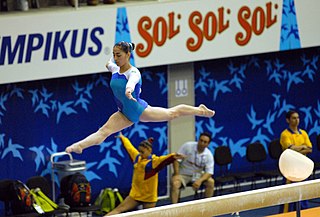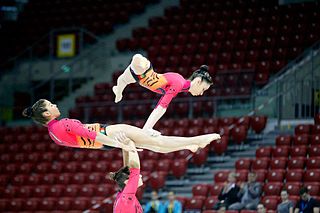
Gymnastics is a sport that includes exercises requiring balance, strength, flexibility, agility, coordination and endurance. The movements involved in gymnastics contribute to the development of the arms, legs, shoulders, back, chest and abdominal muscle groups. Alertness, precision, daring, self-confidence and self-discipline are mental traits that can also be developed through gymnastics. Gymnastics evolved from exercises used by the ancient Greeks that included skills for mounting and dismounting a horse, and from circus performance skills

Aerobics is a form of physical exercise that combines rhythmic aerobic exercise with stretching and strength training routines with the goal of improving all elements of fitness. It is usually performed to music and may be practiced in a group setting led by an instructor, although it can be done solo and without musical accompaniment. With the goal of preventing illness and promoting physical fitness, practitioners perform various routines comprising a number of different dance-like exercises. Formal aerobics classes are divided into different levels of intensity and complexity. A well-balanced aerobics class will have five components: warm-up, cardio vascular conditioning, muscular strength and conditioning, cool-down and stretching and flexibility. Aerobics classes may allow participants to select their level of participation according to their fitness level. Many gyms offer a variety of aerobic classes. Each class is designed for a certain level of experience and taught by a certified instructor with a specialty area related to their particular class.

Trampolining or trampoline gymnastics is a recreational activity, acrobatic training tool as well as a competitive Olympic sport in which athletes perform acrobatics while bouncing on a trampoline. In competition, these can include simple jumps in the straight, pike, tuck, or straddle position to more complex combinations of forward or backward somersaults and twists. Scoring is based on the difficulty and on the total seconds spent in the air. Points are deducted for bad form and horizontal displacement from the center of the bed.
Formation dance is a style of ballroom dancing. It is pattern or shadow team dancing by couples in a formation team. The choreography may be based on a particular dance or a medley of dances. Formation dancing may be done for exhibition or for competition between teams. There is also a type of formation in Bhangra.
The Code of Points is a rulebook that defines the scoring system for each level of competition in gymnastics. There is not a universal international Code of Points, and every oversight organization — such as the FIG, NCAA Gymnastics, and most national gymnastics federations — designs and employs its own unique Code of Points.
Freestyle to Music, sometimes known as Musical Kur or simply kur is a form of dressage competition where the horses paces are set to music to create a competitive "dance". Movements and figures are choreographed to meet the technical requirements of the particular level with carefully chosen music that highlights the horse/rider combination. Musical Freestyles are entertaining and offer great audience appeal. International level competition comprises Prix St. Georges for Young Riders, Intermediate I and Grand Prix through the Fédération Équestre Internationale (FEI).
Minnesota High School Speech refers to the competitive forensics system in the state of Minnesota. These activities are currently coordinated and organized by the Minnesota State High School League, otherwise known as the MSHSL.
Competition aerobatics is an air sport in which judges rate the skill of pilots performing aerobatic flying. It is practiced in both piston-powered single-engine airplanes and gliders.

The UAAP Cheerdance Competition is an annual one-day event of the University Athletic Association of the Philippines for cheerdancing. The sequence of the performance are determined by drawing of lots prior the competition.

A dance squad or dance team, sometimes called a pom squad or song team, is a team of participants that participates in competitive dance. In a routine, a squad will incorporate a specific dance style, technical work, and, depending on the routine, pom-poms and/or cheers. A pom squad slightly differs from a regular dance squad in that it uses pom-poms in all its dance routines, whilst a regular dance squad may or may not do pom work in a dance routine. Dance teams are also popular in performance dance, especially at sporting events, most commonly performing during the pre-game and halftime periods of football and basketball games.
The ISU Judging System, occasionally referred to as the Code of Points (COP) system, is the scoring system currently used to judge the figure skating disciplines of men's and ladies' singles, pair skating, ice dance, and synchronized skating. It was designed and implemented by the International Skating Union (ISU), the ruling body of the sport. This system of scoring is used in all international competitions sanctioned by the ISU, including the Olympic Games. The ISU Judging System replaced the previous 6.0 system in 2004. This new system was created in response to the 2002 Winter Olympics figure skating scandal, in an attempt to make the scoring system more objective and less vulnerable to abuse.

Acrobatic gymnastics is a competitive gymnastic discipline where partnerships of gymnasts work together and perform figures consisting of acrobatic moves, dance and tumbling, set to music. There are three types of routines; a 'balance' routine where the focus is on strength, poise and flexibility; a 'dynamic' routine which includes throws, somersaults and catches, and a 'combined' routine which includes elements from both balance and dynamic.
Andover High School is a four-year public high school at 2115 Andover Blvd, Andover, Minnesota. It is a part of Anoka-Hennepin School District 11 and is one of five traditional high schools in the district. It is the district's newest high school, opening in 2002. The first class graduated from Andover High School in 2004; the first class to have attended all four years of high school there graduated in 2006. It has students from both Andover and Ham Lake. The school's student population is 1750; they are 1% Native American, 1% Hispanic, 2% Asian, 3% African American, and 93% Caucasian.
The International Pole Championship (IPC) is a competition organized annually by International Pole Dance Fitness Association (IPDFA). It is the brainchild of renowned performer and instructor Ania/Anna Przeplasko. It is the world's first international pole dance fitness championship where winners are credited solely for their dance skills, trick techniques and overall showmanship. The IPC is the only pole competition that gathers the world's best men and women. Winners of national championships are granted entry to this championship. Undiscovered talents can submit a video entry via the IPC website where the winner of online voting gains, along with the title Pole Idol, sponsorship to the Grand Finals.
The UAAP Street Dance Competition is a new annual event of the University Athletic Association of the Philippines during the closing ceremonies. This is to encourage more students to watch since less spectators attend the closing ceremonies, where players are awarded for their performance. Results of the street dance competition, together with the drum line competition, will not be added to the computation of UAAP Overall Championship.
Stunt is a new and growing sport that is very similar to cheerleading in terms of athletic skills. In spring 2011, USA Cheer announced that 21 universities are now committed to this sport. STUNT requires high athletic skills and its competition format and scoring systems are unique. The maximum number of players on each team can reach 30 athletes. STUNT athletes are engaged from multiple backgrounds, including traditional cheerleading schools, “All Stars” who are non-school cheerleaders and acrobatics and/or gymnastics athletes. STUNT is being considered for NCAA Emerging Sport status and has been designed to meet Title IX's requirements for intercollegiate sports.
The 2015 Four Continents Figure Skating Championships was a Senior ISU figure skating championship held in the 2014–15 season. Skaters competed in the disciplines of men's singles, ladies' singles, pair skating, and ice dancing for the title of Four Continents Champion. The event's name refers to the Americas, Asia, Africa, and Oceania, which are four of the continents represented in the Olympic rings, omitting Europe.

World of Dance is an American reality competition television series executive produced by Jennifer Lopez. The first two seasons were hosted by Jenna Dewan, the third season is hosted by Scott Evans.. The series features dance performers, including solo acts and larger groups, representing any style of dance, competing for a grand prize of $1 million. The contestants are scored by judges Jennifer Lopez, Ne-Yo, and Derek Hough.










